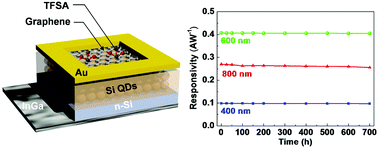Enhancement of efficiency and long-term stability in graphene/Si-quantum-dot heterojunction photodetectors by employing bis(trifluoromethanesulfonyl)-amide as a dopant for graphene†
Abstract
We for the first time employ bis(trifluoromethanesulfonyl)-amide as a dopant for graphene to enhance the efficiency and the stability of graphene/Si quantum dot (SQDs)-embedded SiO2 (SQDs:SiO2) multilayer (ML) heterojunction photodetectors (PDs). With increasing the doping concentration (nD) to 30 mM, the sheet resistance of the doped-graphene transparent conductive electrode (TCE) sharply decreases to ∼155 ohm sq−1 with only 1% reduction in its transmittance at 550 nm, whilst the work function gradually increases to ∼4.95 eV, indicating p-type doping, useful for the graphene/SQDs:SiO2 MLs interface. The DC conductivity/optical conductivity ratio saturates to ∼75 at nD = 20 mM, much larger than the minimum industry standard (= 35) for the optoelectronic applications of TCEs. The PDs optimized at nD = 20 mM exhibit 0.413 A W−1 responsivity (R), 92 dB linear dynamic range, 1.09 × 1010 cm Hz1/2 W−1 detectivity, and 81.33% external quantum efficiency at a peak wavelength of 630 nm, and the loss of R is almost negligible while the PDs are kept for 700 h in air. These characteristics are comparable to those of commercially-available Si PDs and better than those of previously-reported graphene/Si PDs.



 Please wait while we load your content...
Please wait while we load your content...